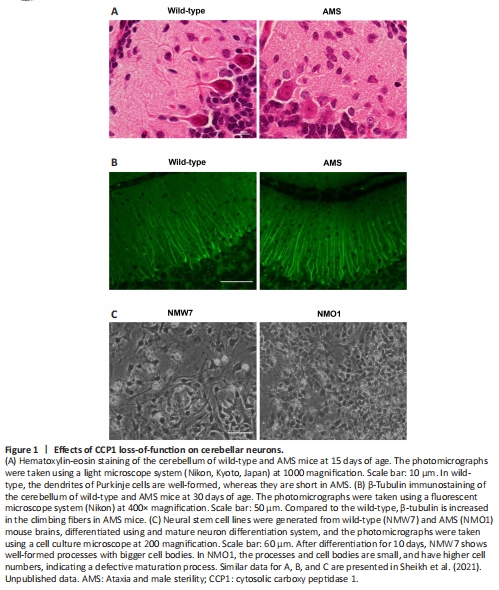神经退行性病
-
Figure 1|Effects of CCP1 loss-of-function on cerebellar neurons.

Various mouse models have been generated to study microtubule glutamylation, including both genetically engineered models and spontaneously arising ones. Spontaneous mouse models with loss-of-function mutations in CCP1 demonstrate tubulin hyper-glutamylation and early degeneration of Purkinje cells, suggesting a pathological implication for alterations in glutamylation. These models, such as Purkinje cell degeneration and ataxia and male sterility (AMS) mice, have been extensively investigated to unravel the causes of Purkinje cell degeneration (Sheikh et al., 2021). Purkinje cells are known for their extensively branched dendrites. In rodents, Purkinje cells undergo a maturation process during the first two weeks after birth, leading to profound morphological changes. Since PC degeneration begins shortly after this time point, CCP1 may play an important role during maturation and synaptic connection. Other potential causes of Purkinje cell degeneration include (1) failure of microtubule-mediated transport or (2) failure of other cellular functions. Notably, a study demonstrated that loss-of-function mutations in CCP1 led to decreased mitochondrial functions. In our experiments, we observed that glutamylation status in the dendrites of Purkinje cells was increased prior to degeneration in CCP1 loss-of-function AMS mice (Sheikh et al., 2021). A previous study showed that hyper-glutamylation both stabilized microtubules in the cell bodies but destabilized them in the axoneme. In AMS, the Purkinje cell dendrites appeared shorter than their wild-type counterparts (Figure 1A), indicating defective dendrite formation, possibly due to microtubule stabilization. However, β-tubulin levels in the climbing fibers of the cerebellum in AMS were increased compared to their wild-type counterparts (Figure 1B), suggesting that glutamylation might enhance their stability. As both axons and dendrites are neuronal processes, it is conceivable that hyper-glutamylation in dendritic tubulin might reduce microtubule severing, leading to improper microtubule generation and the formation of extensive dendritic trees. Consequently, the extensive connections with granule cells may fail to form, resulting in decreased trophic signals to the Purkinje cells. Notably, in neuronal cultures, homozygous CCP1 mutation showed a decreased process size (Figure 1C). Given that dendrites exhibit more plasticity compared to axons and Purkinje cell dendrites are highly branched, they are affected earlier in AMS due to improper connections with the climbing fibers of granule neurons. Granule cells also undergo degeneration in AMS, albeit at a slower pace. The cause of degeneration could be attributed to disruptions in axonal transport and other cellular physiological functions due to hyper-glutamylation.